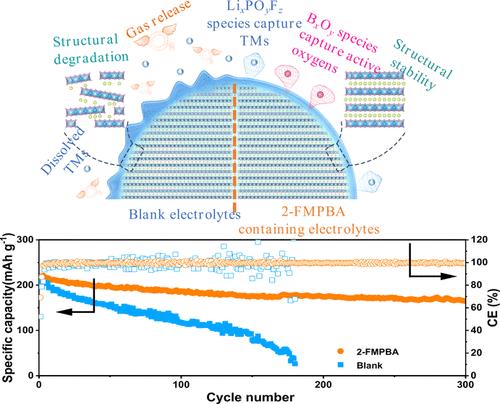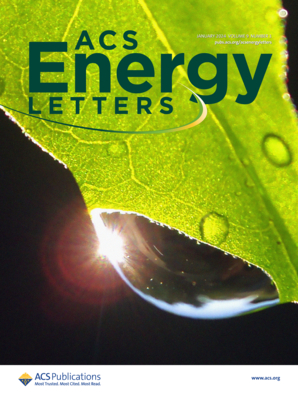分子/离子锚定相实现 4.8 V 快速循环锂金属电池
IF 19.3
1区 材料科学
Q1 CHEMISTRY, PHYSICAL
引用次数: 0
摘要
具有高电压富镍层状阴极的锂(Li)金属电池是下一代高能量密度电池中最有前途的候选电池之一。然而,它们的实际应用却受到高截止电压下结构退化和枝晶生长失控的阻碍。在此,我们提出了一种精确的分子/离子锚定策略,通过探索一种电解质添加剂,在 5 C 下 4.8 V 的超高截止电压条件下实现锂金属电池的稳定循环性能。该添加剂有助于在阴极和阳极上形成由 BxOy、LiF 和 LixPOyFz 物种组成的相间薄层。阴极相间层可通过螯合反应和路易斯碱-酸相互作用抑制气体释放和过渡金属离子溶解。此外,阳极间相还能实现均匀的锂沉积,使库仑效率(CE)高达 99.34%。因此,Li||NCM622 电池在 4.8 V 电压下循环 300 次后仍能保持 80% 的容量。本文章由计算机程序翻译,如有差异,请以英文原文为准。

Molecule/Ion Anchoring Interphase Achieving 4.8 V Fast-Cycling Lithium Metal Batteries
Lithium (Li) metal batteries with high-voltage nickel-rich layered cathodes are some of the most promising candidates for next-generation high-energy-density batteries. However, their practical application is hindered by the structural degradation and uncontrollable dendrite growth at high cutoff voltage. Here, we present a precise molecule/ion anchoring strategy to achieve stable cycling performance of a Li metal battery under an ultrahigh cutoff voltage of 4.8 V at 5 C by exploring an electrolyte additive. The additive facilitates the formation of a thin interphase layer composed of BxOy, LiF, and LixPOyFz species on both cathodes and anodes. The cathode interphase could inhibit the gas release and transition metal ion dissolution through chelation reaction and Lewis base-acid interaction. Additionally, the anode interphase enables uniform Li deposition, resulting in a high Coulombic efficiency (CE) of 99.34%. Therefore, the Li||NCM622 cell can maintain an 80% capacity retention after 300 cycles at 4.8 V.
求助全文
通过发布文献求助,成功后即可免费获取论文全文。
去求助
来源期刊

ACS Energy Letters
Energy-Renewable Energy, Sustainability and the Environment
CiteScore
31.20
自引率
5.00%
发文量
469
审稿时长
1 months
期刊介绍:
ACS Energy Letters is a monthly journal that publishes papers reporting new scientific advances in energy research. The journal focuses on topics that are of interest to scientists working in the fundamental and applied sciences. Rapid publication is a central criterion for acceptance, and the journal is known for its quick publication times, with an average of 4-6 weeks from submission to web publication in As Soon As Publishable format.
ACS Energy Letters is ranked as the number one journal in the Web of Science Electrochemistry category. It also ranks within the top 10 journals for Physical Chemistry, Energy & Fuels, and Nanoscience & Nanotechnology.
The journal offers several types of articles, including Letters, Energy Express, Perspectives, Reviews, Editorials, Viewpoints and Energy Focus. Additionally, authors have the option to submit videos that summarize or support the information presented in a Perspective or Review article, which can be highlighted on the journal's website. ACS Energy Letters is abstracted and indexed in Chemical Abstracts Service/SciFinder, EBSCO-summon, PubMed, Web of Science, Scopus and Portico.
 求助内容:
求助内容: 应助结果提醒方式:
应助结果提醒方式:


